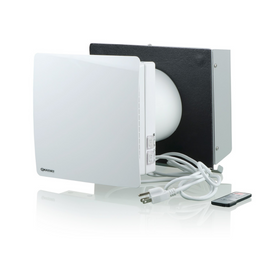
What Can Homeowners Do to Fight Climate Change?
Last Updated: Feb 9, 2025According to the EPA, the burning of fossil fuels for heat, electricity, and transportation is the largest source of GHG emissions from human activities in the United States. Putting aside transportation, for this piece, we'll concentrate here on the impact of burning fossil fuels as homeowners. Everyone can positively influence climate change with acts as simple as reducing our households' energy consumption.
Table of Contents
- Steps to Start Fighting Climate Change at Home
- What People Can Do On Their Own To Fight Climate Change
- What People Can Do Together to Fight Climate Change

Steps to Start Fighting Climate Change at Home
Sometimes, jumping into the fight against climate change can feel daunting and overwhelming, even for those who consider themselves environmentalists. To find tips and strategies for actions we can undertake to help change happen, we consulted with Jodi Stark of Canadian-based David Suzuki Foundation. The David Suzuki Foundation's mission to "conserve and protect the natural environment of Canada." This mission addresses climate change, oceans and cities, biodiversity, and environmental rights, among others, through research, policy analysis, education, and citizen empowerment. This non-profit receives no government money and is funded instead by individual donors, foundation grants, and corporate support.
In 2018, Rise spoke with Jodi Stark, the David Suzuki Foundation's public engagement specialist. Today, we want to shine a light on this inspiring interview again. Jodi has been committed to environmental justice since her late teens. Her experience includes the study of oceans, climate change, tar sands, pipelines, and tankers. Her current areas of focus and expertise are climate change and clean energy. She works for the David Suzuki Foundation while also pursuing her passion for woodworking (see her gorgeous repurposed wood designs at jodistark.ca and Stark Nature Designs on Facebook). At the time of the interview, Jodi clarified what a "public engagement specialist" is—and it is not a public relations position. She said, "That work would be to craft messaging, and communications like: 'What should we tell people, and how?'". Instead, her role seeks answers to questions like: "What do we want people to do, and how can we make it easy for them to do it?" It sounds like just what we need.
What People Can Do On Their Own To Fight Climate Change
We posed several questions around the topics of what everyday homeowners can, are, and are not doing to help address climate change. Here are our queries and some of Stark's thoughtful answers, edited for clarity.

Why do you think sustainability isn't more on peoples' radars?
"I think it's good to challenge that assumption," Stark replies. "I think it is on peoples' minds." People are making sustainable choices, she says, in lots of ways: using reclaimed wood, for example, or paying attention to energy efficiency. When they don't make green choices, she continues, you can't conclude it isn't on their radars, because practical barriers often come into play. Cost is one: While sustainable choices often pay off in the long run (think argon-gas-filled double or triple pane windows), the initial investment may not be affordable to some people. Similarly, insufficient time and money may affect homeowner's decisions. They might choose to tear down an existing structure and replace it with a new one instead of carefully analyzing how each component of the old structure might be repurposed, sold, or donated. "To deconstruct a home and repurpose all the materials costs a lot more upfront than simple demolition," she says, in part because systems are not yet set up and in place to divert materials from the waste stream. A third example of what people may want to do but can't is that homeowners may have difficulty accessing green products and contractors, especially without economies of scale in lower-populated areas.

What are homeowners struggling with the most?
"There is a kind of sexiness right now around renewable energy," Stark says, "but energy efficiency is really the lowest-hanging fruit." Ideally, she says, we would all be investigating and installing the best renewable energy sources, like solar and wind, and ensuring its energy efficiency, once in place. "But, usually, a better starting place is saving energy rather than generating energy." This means evaluating the energy efficiency of your home, right now. Investigate things like insulation, windows, programmable thermostats. For new builds, design elements also come into play: is the home-oriented for maximum direct sunlight in autumn and winter? Whatever power you're using—solar, wind, gas, coal, oil—you'll use less, says Stark, if you work first on your home's energy efficiency.
What are some myths that need to be dispelled about 'going green'?
"There's this idea," says Stark, "that in order to go green people need to live in a former century, that it is limiting, less luxurious, that it would be a life of sacrifice. But in many ways, going green can increase peoples' quality of life." Examples she gives are physical and mental health benefits, including that people often feel more life satisfaction when they make environmentally sound choices. "It's not about going back in time, and it's not about sacrifice. It's about overall improved quality of life."

What are some ways to dispel these myths?
The best way to dispel the myth of going green as limiting and less luxurious, says Stark, is to "empower people who have made [green] choices, to let them tell their stories. They are the people who understand it best. They have pride in how everyone says, 'Look at the design. Look how beautiful!'"
Other "green is limiting" myth-busters, she says, are:
- getting homeowners the right information
- marketing new products widely
- incentivizing the purchase of green products
She cites recycled paper countertops as an example of how markets have difficulty keeping up with innovation. "In many places in Canada," she notes, "you can't just walk into a Home Depot and find them." Given the choice of ordering a new product online (if it's even available online) without seeing it, and waiting extra weeks for it to ship, homeowners may simply opt for a more commercially popular (and less green) option.
Donna Pols Trump
Donna Pols Trump’s work has been published in literary magazines and online. She has received several Pushcart Prize nominations. Donna’s education includes degrees in Biology and Physical Therapy and a host of writing classes taken and taught at The Loft Literary Center in Minneapolis. Her short story “Portage” was selected by judge Anne Tyler for first prize in a 2018 contest sponsored by december magazine.











